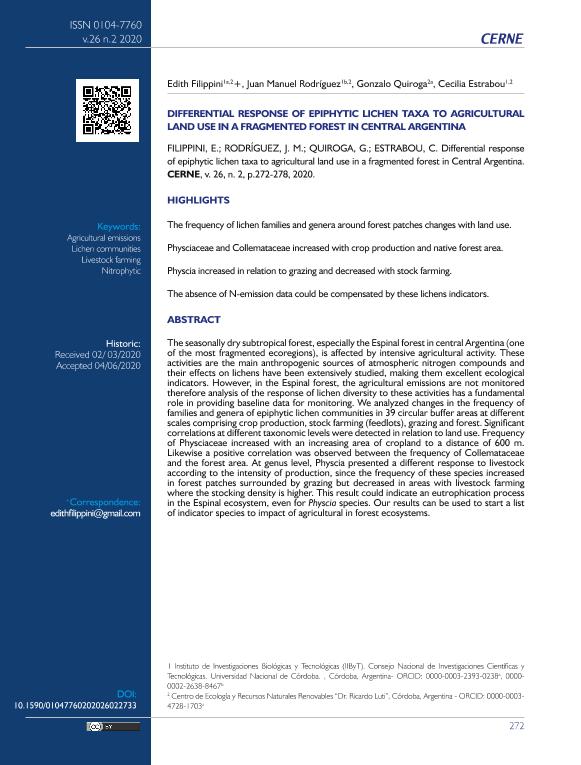Artículo
Differential response of epiphytic lichen taxa to agricultural land use in a fragmented forest in central Argentina
Fecha de publicación:
06/2020
Editorial:
Universidade Federal de Lavras
Revista:
Cerne
ISSN:
0104-7760
Idioma:
Inglés
Tipo de recurso:
Artículo publicado
Clasificación temática:
Resumen
The seasonally dry subtropical forest, especially the Espinal forest in central Argentina (one of the most fragmented ecoregions), is affected by intensive agricultural activity. These activities are the main anthropogenic sources of atmospheric nitrogen compounds and their effects on lichens have been extensively studied, making them excellent ecological indicators. However, in the Espinal forest, the agricultural emissions are not monitored therefore analysis of the response of lichen diversity to these activities has a fundamental role in providing baseline data for monitoring. We analyzed changes in the frequency of families and genera of epiphytic lichen communities in 39 circular buffer areas at different scales comprising crop production, stock farming (feedlots), grazing and forest. Significant correlations at different taxonomic levels were detected in relation to land use. Frequency of Physciaceae increased with an increasing area of cropland to a distance of 600 m. Likewise a positive correlation was observed between the frequency of Collemataceae and the forest area. At genus level, Physcia presented a different response to livestock according to the intensity of production, since the frequency of these species increased in forest patches surrounded by grazing but decreased in areas with livestock farming where the stocking density is higher. This result could indicate an eutrophication process in the Espinal ecosystem, even for Physcia species. Our results can be used to start a list of indicator species to impact of agricultural in forest ecosystems.
Palabras clave:
AGRICULTURAL EMISSIONS
,
LICHEN COMMUNITIES
,
LIVESTOCK FARMING
,
NITROPHYTIC
Archivos asociados
Licencia
Identificadores
Colecciones
Articulos(IIBYT)
Articulos de INSTITUTO DE INVESTIGACIONES BIOLOGICAS Y TECNOLOGICAS
Articulos de INSTITUTO DE INVESTIGACIONES BIOLOGICAS Y TECNOLOGICAS
Citación
Filippini, Edith Raquel; Rodriguez, Juan Manuel; Quiroga, Gonzalo Damián; Estrabou, Cecilia; Differential response of epiphytic lichen taxa to agricultural land use in a fragmented forest in central Argentina; Universidade Federal de Lavras; Cerne; 26; 2; 6-2020; 272-278
Compartir
Altmétricas




